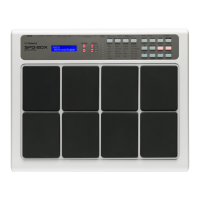5
71
Reverb gives presence and spaciousness to any sound, whether solo or background. However,
excessively high effects levels and long effects times may make the performance difficult to follow
(because sounds are blurred), or make the rhythm less precise. There is a denite relationship between
eect time and eect level. Here are two hints on using Reverb, based on that relationship.
• Ifyouwanttousealongeecttime,decreasetheeectleveltoreducemuddiness.
• Ifyouwanttouseahigheectlevel,shortentheeecttimetoreducemuddiness.
Hints on Using Reverb
While Reverb creates a lingering resonance, Delay creates quite a dierent eect. For Delay eects, the
eect time setting can create signicant dierences in the resulting sound. For example, when playing
a melodic solo using a mallet-type Instrument, an extremely short Delay time can be used to thicken
the sound. On the other hand, a longer repeating Delay can be set to a Delay time of a half-note or
quarternote that matches the tempo of the song.
If you are listening to the SPD-20X in stereo, it can also be interesting to select eect type Panning Delay
and select a Pan setting of “random.”
Hints on Using Delay
For Chorus/Flanger eects, the Time parameter determines the rate (the speed of modulation).
For Chorus, lower settings of the time parameter will result in a more spacious sound, and higher
settings will result in a more tremolo-like effect. Flanging is often used on metallic sounds such as
cymbals or Hi-Hats to produce a frequently-heard eect.
Hints on Using Chorus/Flanger
Eects provide many possibilities, but if you always use the same heavily-applied Reverb or Chorus, all
the Patches will sound the same. It is important to choose eect settings that are appropriate for the
song or suited to the role of the Instrument (solo, backing, special eects, etc.).
The FX SEND in the SOUND parameter group allows you to set the eect depth independently for the
Instrument assigned to each pad, so it is possible, for instance, to apply anging only to the cymbals. In
the case of Reverb, higher settings of FX SEND will create the impression of the Instrument being played
further away, so you might set the FX SEND parameter to a dierent value for each Instrument to create
spatial contrast. By utilizing the Pan setting (the stereo position) and the Chorus eect, you can control a
vast performance space.
Hints on Making Parameter Settings
Speaking of contrast, it can also be very “eective” to not use eects. Some possibilities are as follows.
•ToapplyeectstocertainInstrumentsandnottoothers.
•Toswitchtoanon-eectPatchatastrategicmoment.
As an example of the rst possibility, you might try using an ethnic percussion Instrument—such as a
surdo—without any eects for a feeling of authenticity. As an example of the second possibility, you
could switch from a Patch with deep Reverb to a Patch with no eects (or vice versa) to reinforce musical
movement or development within a song.
Hints on Not Using Eects

